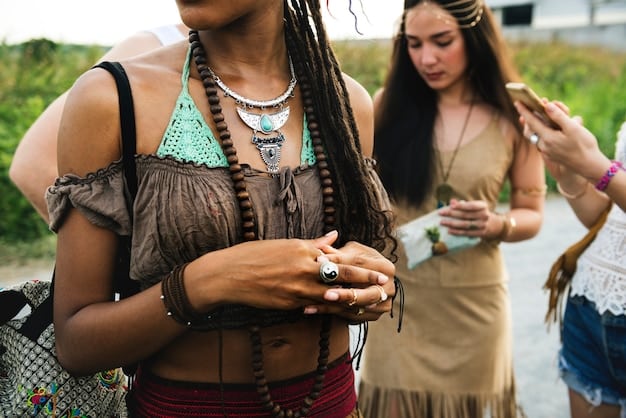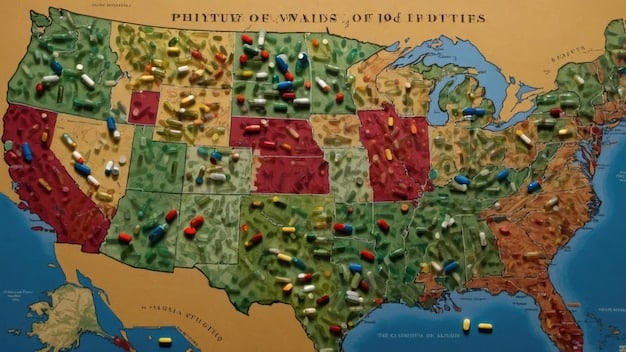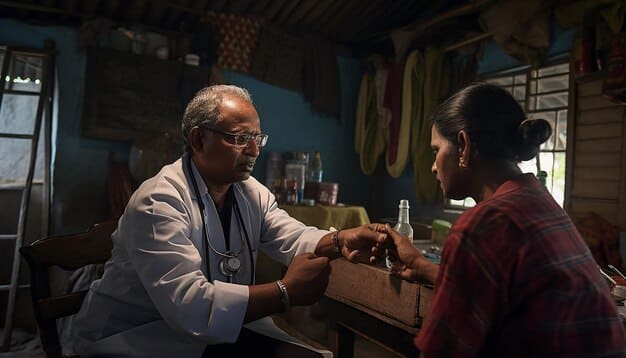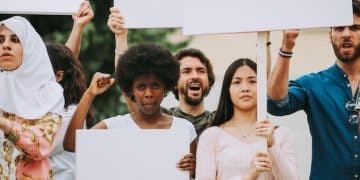Key Challenges for Indigenous Communities in the US & How to Help

The key challenges facing Indigenous communities in the US include systemic discrimination, historical trauma, land rights disputes, inadequate healthcare, and cultural preservation, all of which can be addressed through advocacy, policy changes, and community support.
Understanding the unique challenges faced by Indigenous communities in the US is crucial for fostering a more equitable society. This article explores what are the key challenges facing Indigenous communities in the US and how can we support their rights?
Understanding the Historical Context
To fully grasp the challenges facing Indigenous communities today, it’s essential to understand the historical context. This context is steeped in colonization, forced assimilation, and broken treaties.
Understanding this history provides a vital foundation for comprehending the current struggles for self-determination and justice.
The Legacy of Colonization
Colonization brought immense disruption to Indigenous societies, economies, and ways of life. Land was seized, traditional practices were suppressed, and Indigenous peoples were subjected to discriminatory laws and policies.
Forced Assimilation Policies
Forced assimilation policies aimed to eradicate Indigenous cultures and identities. Boarding schools, for instance, separated children from their families and communities, prohibiting them from speaking their languages or practicing their traditions.
- Loss of cultural identity and language.
- Intergenerational trauma passed down through families.
- Erosion of traditional knowledge and skills.
These historical injustices continue to impact Indigenous communities, contributing to disparities in health, education, and economic opportunity. Addressing these historical traumas is a crucial step towards healing and reconciliation.
Land Rights and Sovereignty
Land rights and sovereignty are fundamental to the well-being and cultural survival of Indigenous communities. Many treaties guaranteeing these rights have been violated or ignored, leading to ongoing disputes and legal battles.
The fight for land rights is also a fight for self-determination and control over their own destinies.

Treaty Rights and Violations
Treaties between Indigenous nations and the US government established specific land boundaries and guaranteed certain rights. However, these treaties have often been violated, resulting in the loss of ancestral lands and resources.
The Importance of Sovereignty
Sovereignty refers to the inherent right of Indigenous nations to govern themselves and make decisions about their own affairs. This includes control over their lands, resources, and cultural practices.
- Economic development opportunities.
- Protection of sacred sites and cultural heritage.
- Self-determination in governance and education.
Supporting Indigenous sovereignty means respecting their right to self-determination and working in partnership to address land rights disputes and other issues. Recognizing and upholding treaty rights is essential for building trust and reconciliation.
Economic Disparities and Poverty
Indigenous communities often face significant economic disparities and high rates of poverty. These challenges are rooted in historical injustices, limited access to education and employment opportunities, and inadequate infrastructure.
Addressing these systemic barriers requires targeted investments in education, job training, and economic development.
Lack of Access to Education
Many Indigenous communities lack access to quality education, which limits their opportunities for economic advancement. Underfunded schools, language barriers, and cultural insensitivity contribute to this challenge.
Limited Employment Opportunities
Employment opportunities in Indigenous communities are often scarce, particularly in rural areas. Discrimination, lack of transportation, and inadequate job training also contribute to high unemployment rates.
Investing in Indigenous-owned businesses and supporting sustainable economic development projects can help create jobs and improve living standards. Additionally, promoting entrepreneurship and providing access to capital can empower Indigenous people to build their own businesses and create economic opportunities in their communities.
Healthcare Disparities
Healthcare disparities are a major concern for Indigenous communities, who often experience higher rates of chronic diseases, mental health issues, and substance abuse. These disparities are linked to poverty, lack of access to healthcare services, and historical trauma.
Addressing these disparities requires culturally competent healthcare, increased funding for Indigenous health programs, and improved access to healthcare services.

Lack of Access to Healthcare Services
Many Indigenous communities live in remote areas with limited access to healthcare clinics, hospitals, and specialists. This geographic isolation makes it difficult for people to receive timely and adequate medical care.
Cultural Barriers to Healthcare
Cultural barriers can also prevent Indigenous people from seeking healthcare. These barriers include language differences, mistrust of the healthcare system, and a lack of culturally appropriate healthcare services.
- Increasing the number of Indigenous healthcare providers.
- Providing culturally sensitive training for healthcare professionals.
- Integrating traditional healing practices into healthcare services.
Improving healthcare outcomes for Indigenous communities requires a multifaceted approach that addresses both access and cultural barriers. By working in partnership with Indigenous nations and communities, we can create a more equitable and culturally responsive healthcare system.
Preserving Indigenous Cultures and Languages
Preserving Indigenous cultures and languages is essential for maintaining their unique identities and passing on their traditions to future generations. However, these cultures and languages are threatened by assimilation, discrimination, and the loss of traditional lands.
Supporting Indigenous cultural revitalization efforts, language programs, and cultural centers is crucial for ensuring the survival of these vibrant and diverse cultures.
The Importance of Language Revitalization
Language is a fundamental part of culture, and the loss of Indigenous languages represents a significant cultural loss. Language revitalization programs are essential for preserving these languages and passing them on to future generations.
Supporting Cultural Centers and Programs
Cultural centers and programs play a vital role in preserving Indigenous cultures and traditions. These centers provide a space for people to gather, learn, and share their cultural heritage.
- Supporting Indigenous artists and artisans.
- Promoting Indigenous cultural tourism.
- Educating the public about Indigenous cultures and histories.
By investing in Indigenous cultural revitalization efforts, we can help ensure that these vibrant cultures continue to thrive for generations to come. Honoring and celebrating Indigenous cultures enriches our society as a whole and promotes greater understanding and respect.
Addressing Systemic Discrimination
Systemic discrimination continues to affect Indigenous communities in many areas, including education, employment, housing, and the justice system. Overcoming this discrimination requires addressing the root causes of prejudice and promoting policies and practices that advance equality and opportunity.
This includes enacting anti-discrimination laws, promoting cultural awareness, and ensuring that Indigenous people have equal access to resources and services.
Bias in the Justice System
Indigenous people are disproportionately represented in the criminal justice system, often facing harsher sentences and discriminatory treatment. Addressing this bias requires reforms to law enforcement practices, judicial training, and sentencing guidelines.
Discrimination in Housing and Employment
Indigenous people often face discrimination in housing and employment, limiting their access to safe and affordable housing and preventing them from securing stable jobs. Enforcing anti-discrimination laws and promoting fair housing and employment practices are essential for addressing these inequalities.
Additionally, promoting diversity and inclusion in workplaces and schools can help create a more welcoming and equitable environment for Indigenous people. By challenging stereotypes and promoting understanding, we can break down barriers and create opportunities for Indigenous people to thrive.
| Key Issue | Brief Description |
|---|---|
| 🏠 Land Rights | Ongoing disputes over treaty rights and ancestral lands. |
| ⚕️ Healthcare Disparities | Limited access to quality healthcare and cultural barriers. |
| 💰 Economic Disparities | High poverty rates and limited employment opportunities. |
| 🗣️ Cultural Preservation | Threats to Indigenous languages and cultural practices. |
Frequently Asked Questions
▼
Indigenous youth face challenges like limited educational opportunities, high rates of suicide, and cultural disconnection. Support includes culturally relevant programs and mental health services.
▼
You can support Indigenous-owned businesses by purchasing their products and services, promoting them within your network, and advocating for policies that support Indigenous entrepreneurship.
▼
Treaty rights are crucial as they affirm Indigenous sovereignty and guarantee certain rights and protections. Upholding these rights is vital for justice and reconciliation.
▼
Historical trauma leads to mental health issues, substance abuse, and social problems across generations. Addressing it requires healing ceremonies and culturally appropriate support.
▼
Education promotes awareness of Indigenous cultures and histories, challenges stereotypes, and empowers Indigenous communities to advocate for their rights and self-determination effectively.
Conclusion
Addressing the challenges facing Indigenous communities requires a commitment to justice, equity, and respect for self-determination. By working in partnership with Indigenous nations and communities, we can create a more just and equitable society for all.





